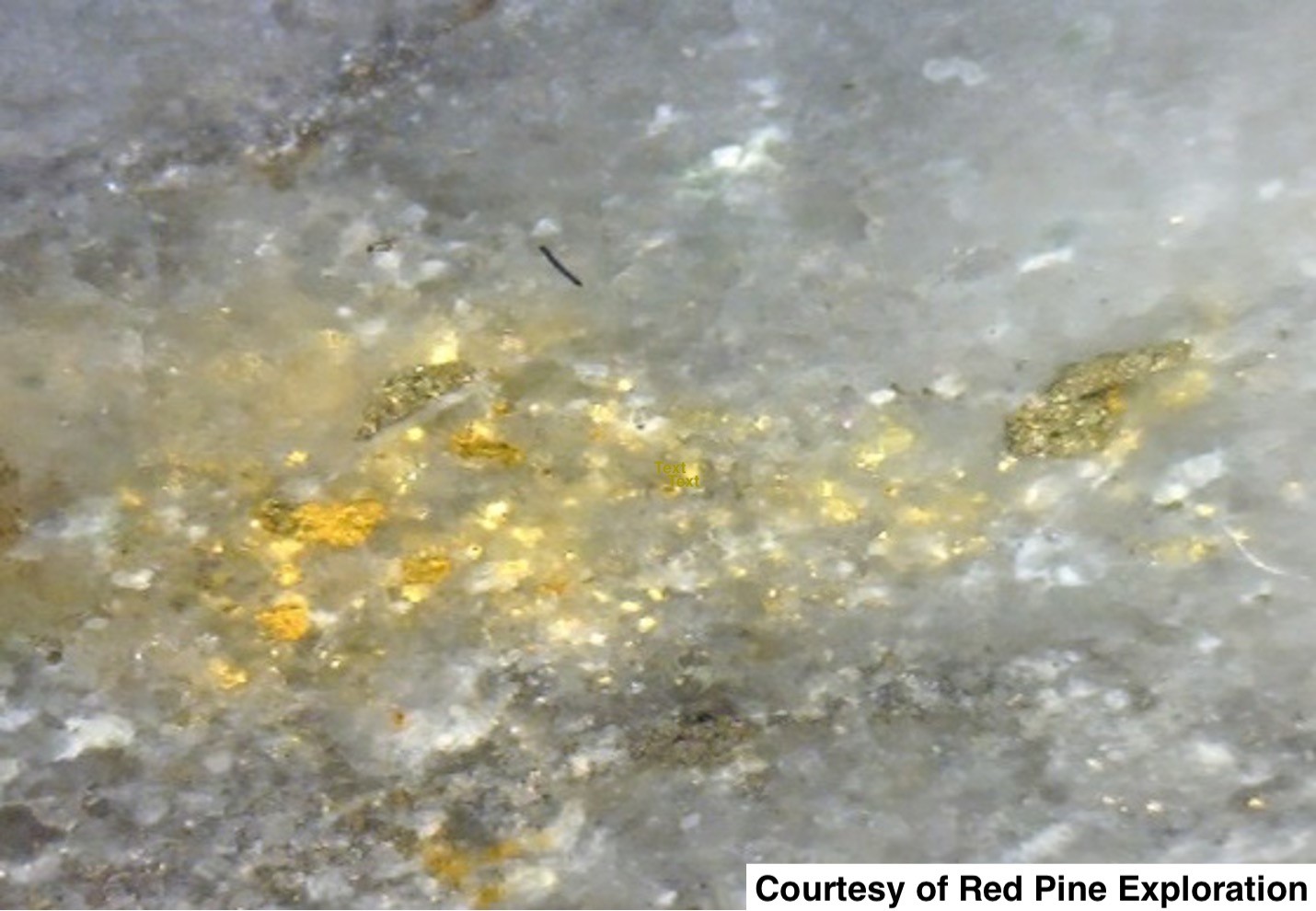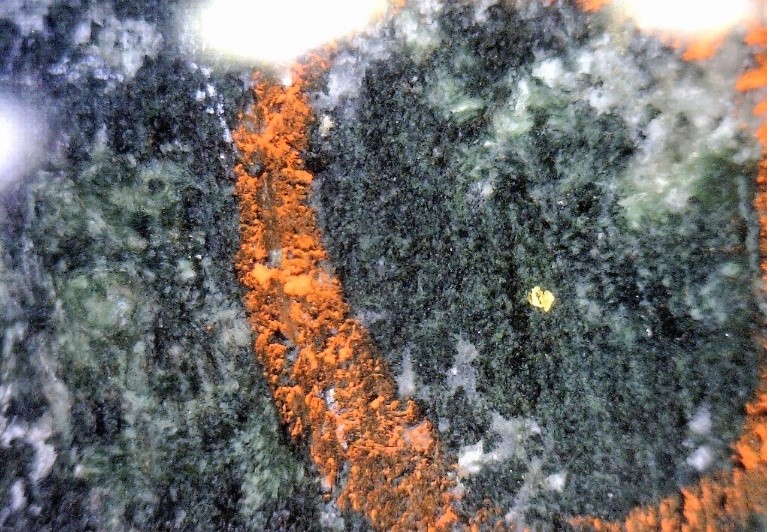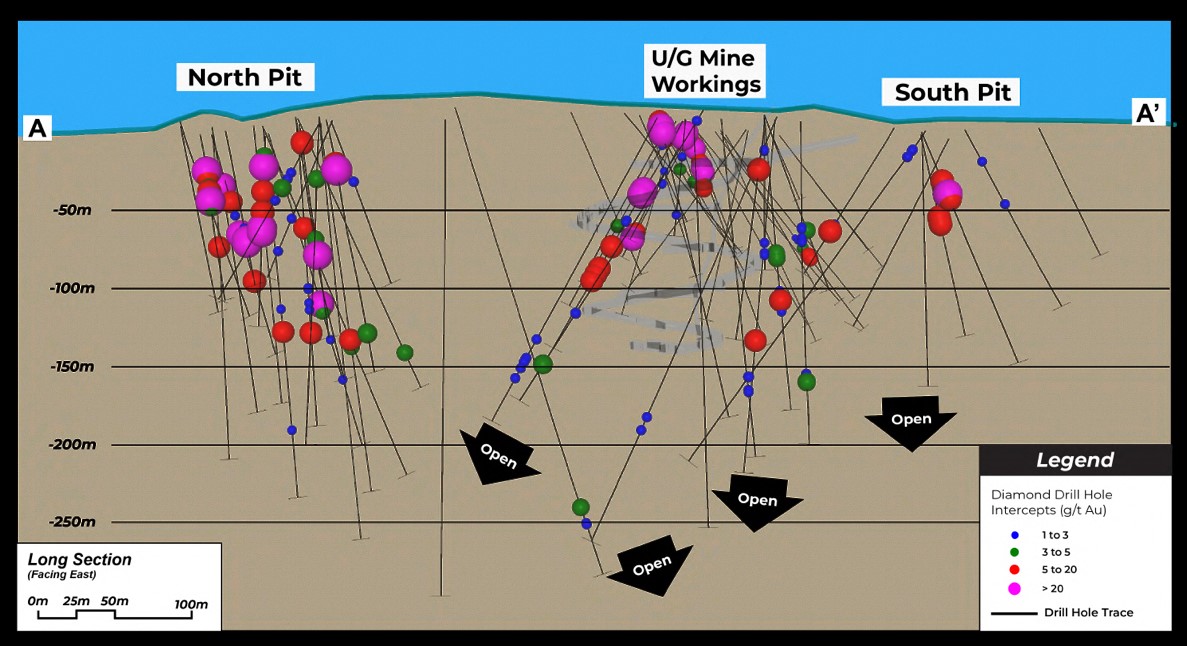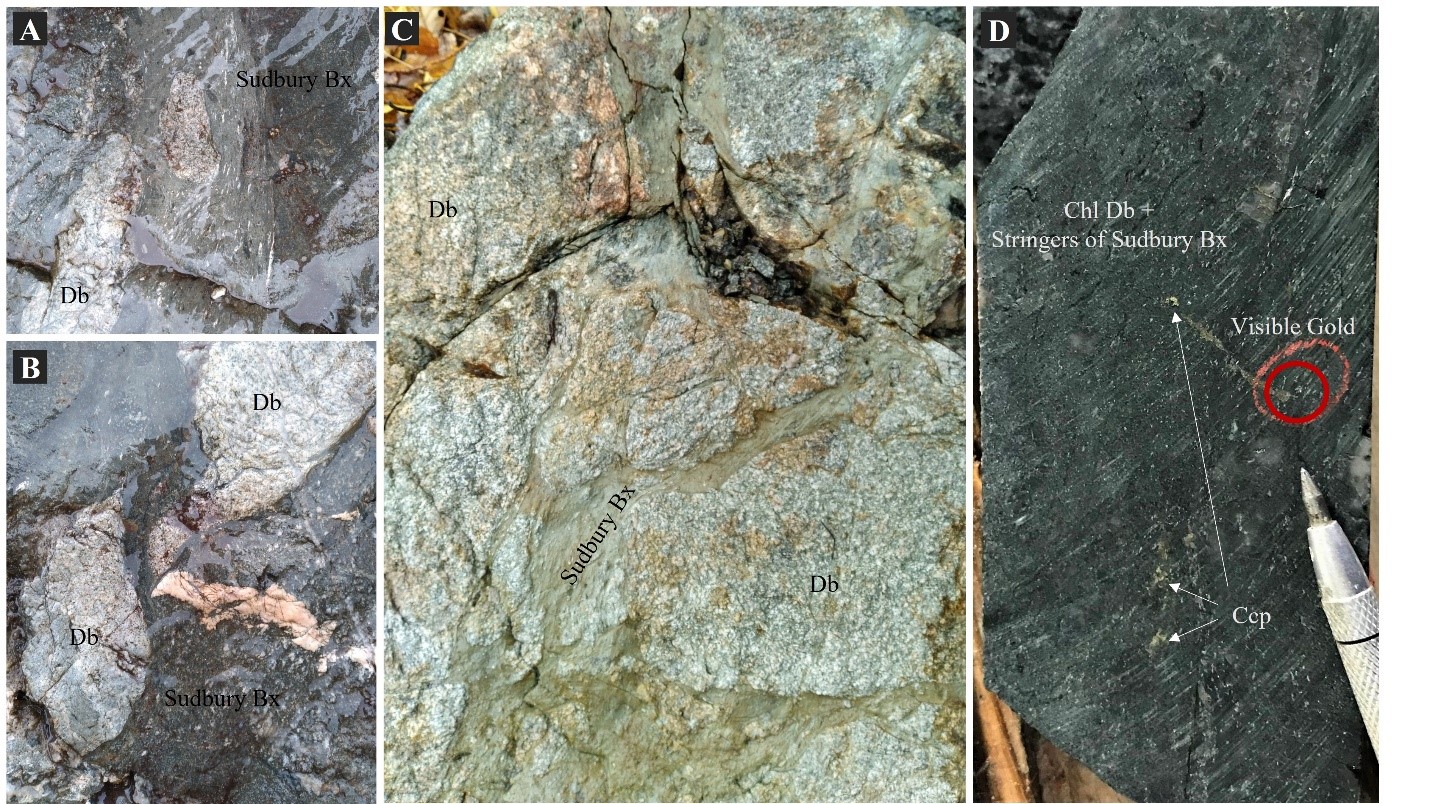Highlights
- Very high-grade Au mineralization demonstrated at Scadding and indicated at Glade, located ~1 km to the south.
- Scadding North Zone:
- 59.2 g/t Au over 19.07 m, including 735.50 g/t Au over 0.96 m in hole SM-20-026
- 52.0 g/t Au over g/t Au over er 12.27 m, including 179.20 g/t Au over 1.15 m in hole SM-19-001
- Scadding Central Zone:
- 7.18 g/t Au over 13.23 m, including 41.44 g/t Au over 1.09 m in SM-20-065
- Scadding East-West Zone:
- 10.97 g/t Au over 4.98 m & 10.80 g/t Au over 14.20m, including 70.80 g/t Au over 0.95 m in SM-19-022
- Glade:
- 5.17 g/t Au over 22.67 m, including 113.00 g/t Au over 0.96 m in AG-21-097
- 0.72 g/t Au over 37.45 m, including 16.0 g/t Au over 1.0 m in AG-22-105
- 0.82 g/t Au over 40.5 m, including 7.76 g/t Au over 2.9 m in AG-22-103
- Scadding North Zone:
- Drilling and surface exploration at Glade in 2021-2022 has provided strong evidence linking gold mineralization at Glade to the very high grade Au mineralization measured at the historic Scadding mine.
- Evolution from quartz to quartz-chlorite to chlorite in association with gold mineralization
- Spatial relation of gold mineralization with zones of strong Fe-alteration (magnetite and/or chlorite) in Espanola Formation limestone
- Both targets remain fully open in all directions
Scadding Mine
- High grade gold intercepts in the North, South, East-West and Central zones of the historic Scadding mine site
- North Zone:
- 59.2 g/t Au over 19.07 m, including 735.50 g/t Au over 0.96 m in hole SM-20-026
- 52.0 g/t Au over g/t Au over er 12.27 m, including 179.20 g/t Au over 1.15 m in hole SM-19-001
- Central Zone:
- 7.18 g/t Au over 13.23 m, including 41.44 g/t Au over 1.09 m in SM-20-065
- East-West Zone:
- 10.97 g/t Au over 4.98 m & 10.80 g/t Au over 14.20m, including 70.80 g/t Au over 0.95 m in SM-19-022
- South Zone:
- 3.90 g/t Au over 17.06 m, including 20.54 g/t Au over 1.0 m & 17.61 g/t Au over 1.19 m in SM-20-062
- Deposit remains open in all directions, with strongest potential of predicting very high grade gold mineralization in the North zone (drilled by MacDonald Mines in 2019-2020) 3.Critical metals mineralization including the presence of Au-Co in Bristol Breccia
- 0.1 g/t Au and 0.045% Co over 1.93 m in SM-19-024
- 0.83 g/t Au and 0.011% Co over 13.82 m in SM-20-058
The historic Scadding Mine, located within our property, produced 29,000 oz of gold at a head grade of 7.2 g/t (OFR 5771). The four images below demonstrate the contrast in the Scadding gold mineralization vs. typical orogenic gold mineralization, such as that of the Surluga Deposit in the Wawa Gold Camp, Ontario. At Scadding mine the gold is hosted within strongly albitized sediments that have undergone intense iron metasomatism, resulting in dark green rocks with visible gold hosted in the Fe-rich chloritic matrix with variable magnetite, pyrite, pyrrhotite and minor to accessory chalcopyrite (iron-sulfide alteration).




The Scadding Deposit has seen a considerable amount of exploration drilling (30,338 metres of diamond drilling by 7 operators) and many factors hindered the successful development of the property area:
- Atypical style of gold mineralization in a Canadian context
- Structural complexity of mineralized zones
- High uncertainty on the locations of historic collars
- Data processing and database mistakes
Nevertheless, since initiating exploration in the summer of 2018, our drilling results support the hypothesis that gold mineralization in the Scadding deposit is primarily controlled by a series of folds that are laterally distributed in a west to east corridor at least 500 metres wide.
During 2019/2020 our team drill tested 83 holes (13,575 m) and discovered mineralization beyond the historical Scadding Mine footprint.


A high-resolution 3D IP survey was completed over the Scadding Deposit area by our exploration team which identified structures (folds) that control the emplacement and geometry, to depth, of the gold-bearing iron/chlorite-rich zones. (Place below image below this paragraph on Property Page)
Glade
Highlights
- Shallowly defined gold mineralization demonstrated in drilling and channel samples over approximately 300 m strike length that remains fully open in all direction with potential for very high-grade mineralization.
- 5.17 g/t Au over 22.67 m, including 113.00 g/t Au over 0.96 m in AG-21-097
- 0.82 g/t Au over 40.5 m, including 7.76 g/t Au over 2.9 m in AG-22-103
- 0.72 g/t Au over 37.45 m, including 16.0 g/t Au over 1.0 m in AG-22-105
- 7.19 g/t Au over 4.0 m, including 12.40 g/t Au over 1.0 m in channel sample from AGT-21-002
- Strike length of entire Glade mineralization trend proposed up to 1.7 km by ALS GoldSpot’s artificial intelligence generated targeting in May 2022.
- Located ~1 km south of the Scadding mine
- Evidence from drilling and surface exploration indicates that Glade is part of the same/extended MIAC mineral system which formed the very high grade gold mineralization at the Scadding mine
- New PGE mineralization potential in Nipissing diabase from 2022 drilling
- 0.16 g/t Pd with anomalous Cu and Ni over 4.00 m in AG-22-103
Summary
In the Glade Area, Ontario Geological Survey maps and historical exploration identified a broad zone of disruption, alteration, deformation, and mineralization that extends over a strike length of approximately 300 m, with high-grade gold in quartz veins historically reported.
Work in the Glade area has primarily focussed on the Glade West (AGT-21-005/006) and Glade East showings (AGT-21-002) identified in the 1930’s and 1940’s, approximately 260 m apart. The showings were prospected by Macdonald Mines in 2019 where grab samples from Glade west returned up to 18.53 g/t Au and channel samples from Glade East in 2021 returned 7.19 g/t Au over 4.0m, including 12.40 g/t Au over 1.0m. IP surveys were completed over the Glade area in 2020 in order to assist with drill targeting.
Drilling under Glade West revealed a large alteration and mineralized system where shear-hosted quartz veins are surrounded by networks of gold mineralized, multi directional and variable spaced quartz tension veins concentrated in the Nipissing intrusion. New observations from 2022 drilling also identified the potential for the Nipissing diabase at Glade to host PGE mineralization, with 0.16 g/t Pd and anomalous Cu and Ni over 4.0 m in hole AG-22-103.

Visible Gold was observed in quartz veins in 5 out of the 6 drillholes completed by the MacDonald Mines at Glade to date. In certain quartz veins, visible gold is associated with iron-rich chlorite alteration emplaced and crosscutting the quartz veins. This association between gold and iron-rich chlorite is similar to the association between iron-chlorite and gold at the Scadding Deposit. At Scadding, gold mineralization is primarily associated with the chlorite to chlorite-quartz to quartz-chlorite mineral facies, with the transition between these facies demonstrated very clearly at the Villeneuve trench near the East-West zone. Contrastingly at Glade, gold mineralization is primarily associated with the quartz to quartz-chlorite mineral facies, with the first evidence of gold with primarily chlorite observed in 2022 drilling in AG-22-103; the figure below demonstrates gold mineralization at Glade, with the quartz rich facies on the lefthand side and the chlorite rich facies at depth on the right hand side. The relationship between the mineralization observed at Glade and the Scadding Deposit, just 1 km north, potentially represents a considerable extension to that MIAC mineralized system.

In the summer of 2022, the high priority target proposed by ALS GoldSpot Discoveries southeast of the main Glade target was prospected. Gold mineralization was identified within the same quartz-carbonate veining in sheared Nipissing diabase, with up to 2.36 g/t Au measured in muck sample beside historic blast pit. This further supports the extension of Glade mineralization proposed by ALS GoldSpot over a strike length of 1.7 km, proven in drilling and channel samples thus far over approximately 300 m.
Sudbury breccias have been observed at surface at Glade and in drill core from Scadding mine and Glade. In the Glade area at surface, Sudbury breccias occur as networks of centimeter- to meter-wide corridors of brecciation formed in Nipissing intrusions that become preferentially re-activated as shears zones. The matrix of the Sudbury breccias is very fine grained, with rounded clasts of the host rock units and flow-like foliation, which is characteristic of Sudbury breccias as they formed during intense cataclasis and friction melting of the host rocks. In drilling and at surface, the deformed corridors of Sudbury breccias are zones of preferential alteration, veining and mineralization. The breccias are variably albitized, and then overprinted by gold-mineralized chlorite replacement, or cut by quartz and quartz-chlorite veins in the apical parts of the systems. These Sudbury breccias are a primary control on deformation and fluid-infiltration in the Nipissing intrusions away from the Nipissing-Espanola contact.

